 A friend of mine picked up one of the first Subaru BRZ’s in North Carolina last month and he was gracious enough to let me tag along and drive it for a few minutes. This won’t be a complete in-depth review because I wasn’t about to flog my friend’s brand new car. If you’re trying to find out about at-the-limit performance characteristics, read/watch one of the professional media reviews where they beat on a nameless press car. There are plenty of them here on this blog. I’ll be talking more about the philosophy and execution of the car and what kind of buyers it’ll be suited for. The Scion FRS/Subaru BRZ/Toyota GT-86 is supposed to be the spiritual successor of the Toyota AE86 (Corolla GT-S Sport RWD here in the US) which I’ve owned one for the last 10 years, so we’ll see if both cars are cut from the same cloth. Hopefully Subaru/Toyota did a great job of modernizing a cult classic.
A friend of mine picked up one of the first Subaru BRZ’s in North Carolina last month and he was gracious enough to let me tag along and drive it for a few minutes. This won’t be a complete in-depth review because I wasn’t about to flog my friend’s brand new car. If you’re trying to find out about at-the-limit performance characteristics, read/watch one of the professional media reviews where they beat on a nameless press car. There are plenty of them here on this blog. I’ll be talking more about the philosophy and execution of the car and what kind of buyers it’ll be suited for. The Scion FRS/Subaru BRZ/Toyota GT-86 is supposed to be the spiritual successor of the Toyota AE86 (Corolla GT-S Sport RWD here in the US) which I’ve owned one for the last 10 years, so we’ll see if both cars are cut from the same cloth. Hopefully Subaru/Toyota did a great job of modernizing a cult classic.
Exterior Styling
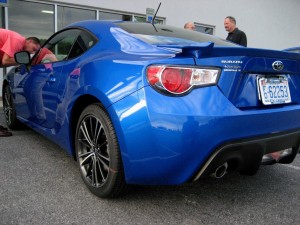 Sports cars are purpose built machines and their styling has to suggest that. You should be able to just get a glimpse of one and think, “Hey, that’s something special.” Driving is like any other hobby in that you can tell apart the beginners and over-enthusiastic wannabes from the experts based on the equipment they use. In the case of the BRZ and the FR-S, there is no mistaking the sharp and distinctive profile as anything but an enthusiast’s car. You can look at pictures on the internet all day long, but you’ll still be impressed the first time you see one in person. The shapes and lines of the BRZ and FR-S embrace the new era of performance styling ushered in by the Audi R8 and the Nissan GT-R.
Sports cars are purpose built machines and their styling has to suggest that. You should be able to just get a glimpse of one and think, “Hey, that’s something special.” Driving is like any other hobby in that you can tell apart the beginners and over-enthusiastic wannabes from the experts based on the equipment they use. In the case of the BRZ and the FR-S, there is no mistaking the sharp and distinctive profile as anything but an enthusiast’s car. You can look at pictures on the internet all day long, but you’ll still be impressed the first time you see one in person. The shapes and lines of the BRZ and FR-S embrace the new era of performance styling ushered in by the Audi R8 and the Nissan GT-R. The sculpted front wheel arches sleekly distinguish themselves from the rest of the front fenders by bulging out over the wheels and slightly over the top of the low hood line (more on this later). They’re complemented by the strong Subaru influenced hips over
The sculpted front wheel arches sleekly distinguish themselves from the rest of the front fenders by bulging out over the wheels and slightly over the top of the low hood line (more on this later). They’re complemented by the strong Subaru influenced hips over  the rear wheels to give the car a look of athletic prowess. The stock wheels are strange when taken out of context, but everything works as a coherent styling package when they’re bolted to the car. Toyota and Subaru’s designers have ensured that the FR-S and BRZ on the cutting edge of automotive styling. It won’t look dated for any time soon. You also won’t mistake one of these for anything else going down the road.
the rear wheels to give the car a look of athletic prowess. The stock wheels are strange when taken out of context, but everything works as a coherent styling package when they’re bolted to the car. Toyota and Subaru’s designers have ensured that the FR-S and BRZ on the cutting edge of automotive styling. It won’t look dated for any time soon. You also won’t mistake one of these for anything else going down the road.
Interior
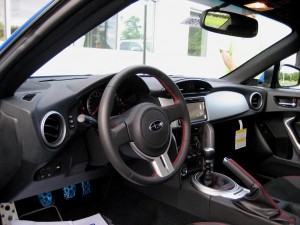 The sporty feel continues in the interior with black leather and alcantara upholstery with contrasting red stitching (the car pictured is a Limited trim package) and silver soft touch plastic accents. All of the controls and gauges are back lit in sports car standard red. There’s an overall feel of tight fit and finish typical of what you would find in other Toyotas or Subarus. No part jumped out as cheap or awkward like it was reused from an economy car to cut costs. There are a few notable differences in the BRZ and Scion FR-S interiors. The most obvious one is the plastic piece on the face of the dash. In the BRZ, it’s a classy matte silver where the FR-S has a glossy black plastic piece with a carbon fiber texture. The BRZ has toggle switches to control the air conditioning where the FR-S has round dials
The sporty feel continues in the interior with black leather and alcantara upholstery with contrasting red stitching (the car pictured is a Limited trim package) and silver soft touch plastic accents. All of the controls and gauges are back lit in sports car standard red. There’s an overall feel of tight fit and finish typical of what you would find in other Toyotas or Subarus. No part jumped out as cheap or awkward like it was reused from an economy car to cut costs. There are a few notable differences in the BRZ and Scion FR-S interiors. The most obvious one is the plastic piece on the face of the dash. In the BRZ, it’s a classy matte silver where the FR-S has a glossy black plastic piece with a carbon fiber texture. The BRZ has toggle switches to control the air conditioning where the FR-S has round dials  similar to the ones found in the rest of the Scion lineup. Lastly, the BRZ has voice activated GPS navigation and Bluetooth pairing as standard equipment where these features aren’t available in the FR-S, even as add-on options. The navigation system in the BRZ zooms in and out at turns so you can plan ahead for your route. The seats are comfortable and well bolstered on the sides. They allow you to sit very low in the car. Trust me, I know. I was able to find a usable seating position which is not an easy task since I’m 6’5″ with a long torso. There are plenty of cars in this segment (Honda S2000, Mazda MX-5) that I can’t drive simply because there isn’t enough space in the cockpit for me to operate all of the controls. I’d have to open the sunroof in the BRZ to wear a helmet, but that’s true of pretty much anything that’s not a full size truck. There is a back seat, but you can barely fit a hand in the leg room when the front seats are in a useful driving position. The BRZ’s seating arrangement is best described as 2+1. The back seat can fit a small person sideways with their legs in the seat next to them for short trips in a pinch, but that’s it. The seats do fold down and you can get luggage or a set of wheels and a jack (as per the request of the enthusiasts interviewed when this car was being designed) in the cargo area. In fact,
similar to the ones found in the rest of the Scion lineup. Lastly, the BRZ has voice activated GPS navigation and Bluetooth pairing as standard equipment where these features aren’t available in the FR-S, even as add-on options. The navigation system in the BRZ zooms in and out at turns so you can plan ahead for your route. The seats are comfortable and well bolstered on the sides. They allow you to sit very low in the car. Trust me, I know. I was able to find a usable seating position which is not an easy task since I’m 6’5″ with a long torso. There are plenty of cars in this segment (Honda S2000, Mazda MX-5) that I can’t drive simply because there isn’t enough space in the cockpit for me to operate all of the controls. I’d have to open the sunroof in the BRZ to wear a helmet, but that’s true of pretty much anything that’s not a full size truck. There is a back seat, but you can barely fit a hand in the leg room when the front seats are in a useful driving position. The BRZ’s seating arrangement is best described as 2+1. The back seat can fit a small person sideways with their legs in the seat next to them for short trips in a pinch, but that’s it. The seats do fold down and you can get luggage or a set of wheels and a jack (as per the request of the enthusiasts interviewed when this car was being designed) in the cargo area. In fact,  four wheels will stack on top of the folded rear seat without blocking rearward visibility while still leaving the entire passenger seat and trunk open for storage. Even though it’s not great for people, the back seat brings down insurance costs and allows for a good amount of storage, which makes the BRZ a lot more flexible vehicle than a true 2 seater.
four wheels will stack on top of the folded rear seat without blocking rearward visibility while still leaving the entire passenger seat and trunk open for storage. Even though it’s not great for people, the back seat brings down insurance costs and allows for a good amount of storage, which makes the BRZ a lot more flexible vehicle than a true 2 seater.
Controls
The steering wheel, shifter and pedals all fall naturally into place and the steering column can be adjusted for angle as well as length. The clutch pedal is extremely light, even by modern car standards. This is fantastic for stop and go traffic, but the learning curve for driving the BRZ smoothly will be steep, especially if you’re used to a stiff clutch in an older car. You’ll have to train your left leg to find the engagement point purely by travel 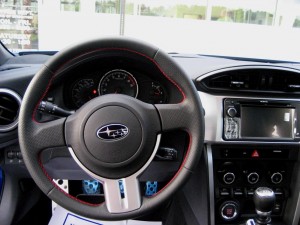 without any resistance changes. The shifter has short, notchy throws but not to a fault. The synchros give plenty of tactile feedback so you know that you haven’t missed the shift. The only odd sensation comes from the way the shifter motion is damped. It feels like the other end of the shift lever is connected to moving parts made of precision machined plastic. This isn’t a bad thing as long as the precision and feedback stay consistent as the bushings wear. The tachometer is front and center in the gauge cluster with a digital speedometer window in the lower right part of the face. It’s also flanked on the left by an analog speedometer, just in case.
without any resistance changes. The shifter has short, notchy throws but not to a fault. The synchros give plenty of tactile feedback so you know that you haven’t missed the shift. The only odd sensation comes from the way the shifter motion is damped. It feels like the other end of the shift lever is connected to moving parts made of precision machined plastic. This isn’t a bad thing as long as the precision and feedback stay consistent as the bushings wear. The tachometer is front and center in the gauge cluster with a digital speedometer window in the lower right part of the face. It’s also flanked on the left by an analog speedometer, just in case.
Driving Dynamics
Now that we’ve gotten the formalities out of the way, lets get to the good stuff. The BRZ drives like almost nothing else on the road. To say that the car simply “handles well” is really missing what makes it special. It’s a game changing driving experience. In your typical car, the weight of the engine resides some significant distance above the front  axle. Think of sitting on top of a tall bar stool and rocking back and forth to lift the legs off of the floor. It doesn’t take a lot of effort because your body weight has a lot of leverage when it comes to moving the stool and it’s actually quite easy to topple over (Flux Auto assumes no responsibility if you hurt yourself screwing up one of our physics analogies). In a car, the engine’s weight is like your body weight and the front wheels are like the legs of the bar stool. When the car turns, the weight of the engine will want to lean over the outside wheel. The result of this phenomenon is that there’s a delay between when the driver pulls the steering wheel off-center and when the car actually starts turning. This delay is the time it takes for the suspension to absorb the motion of the engine wanting to topple over. The more body roll the car has from soft suspension, the longer this delay is. The stock BRZ is a revolutionary driving experience even though it comes from the factory with the same tires as the Toyota Prius and conservatively soft shocks and springs that do an excellent job absorbing bumps in the road. Basic tire and suspension modifications would take the BRZ and FR-S from being some of the most exceptional steering cars currently produced into true superlative territory if you’re willing to sacrifice the perfect balance of performance and everyday driving the stock setup offers.
axle. Think of sitting on top of a tall bar stool and rocking back and forth to lift the legs off of the floor. It doesn’t take a lot of effort because your body weight has a lot of leverage when it comes to moving the stool and it’s actually quite easy to topple over (Flux Auto assumes no responsibility if you hurt yourself screwing up one of our physics analogies). In a car, the engine’s weight is like your body weight and the front wheels are like the legs of the bar stool. When the car turns, the weight of the engine will want to lean over the outside wheel. The result of this phenomenon is that there’s a delay between when the driver pulls the steering wheel off-center and when the car actually starts turning. This delay is the time it takes for the suspension to absorb the motion of the engine wanting to topple over. The more body roll the car has from soft suspension, the longer this delay is. The stock BRZ is a revolutionary driving experience even though it comes from the factory with the same tires as the Toyota Prius and conservatively soft shocks and springs that do an excellent job absorbing bumps in the road. Basic tire and suspension modifications would take the BRZ and FR-S from being some of the most exceptional steering cars currently produced into true superlative territory if you’re willing to sacrifice the perfect balance of performance and everyday driving the stock setup offers.
The Analogy
I say the BRZ is a fundamentally different driving experience because there is literally zero delay in its steering response. The moment you breathe on the steering wheel, the nose of the car executes the command. The BRZ is able to do this because it has a horizontally opposed boxer engine under the hood. Since the pistons move side to side instead of up and down, the total weight of the engine is much closer to the bottom of the 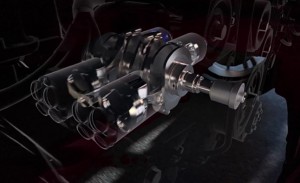 chassis. From behind the wheel, it feels like the flat-four is smack dab in the middle of the two front wheels. Because it sits so low (much lower than it does in other Subarus thanks to the lack of a front differential in the BRZ), the weight of the engine has little leverage when it comes to trying to make the body of the car roll. As a result, the horizontal movement of the front axle is directly connected to the steering wheel without any delay or surge. You are almost guaranteed to over turn the wheel the first time you drive a BRZ of FR-S… unless you own an RX-8. The rotary engine in the RX-8 achieves the same lack of body roll as the boxer engine in the BRZ thanks to its compact size and lack of reciprocating pistons. Why did I bring up the RX-8 in the middle of a BRZ review? It’s a setup for the knowledge bomb I’m about to drop: The Subaru BRZ and Scion FR-S are essentially the rotary Miata coupe that Mazda never built. Boom. There it is.
chassis. From behind the wheel, it feels like the flat-four is smack dab in the middle of the two front wheels. Because it sits so low (much lower than it does in other Subarus thanks to the lack of a front differential in the BRZ), the weight of the engine has little leverage when it comes to trying to make the body of the car roll. As a result, the horizontal movement of the front axle is directly connected to the steering wheel without any delay or surge. You are almost guaranteed to over turn the wheel the first time you drive a BRZ of FR-S… unless you own an RX-8. The rotary engine in the RX-8 achieves the same lack of body roll as the boxer engine in the BRZ thanks to its compact size and lack of reciprocating pistons. Why did I bring up the RX-8 in the middle of a BRZ review? It’s a setup for the knowledge bomb I’m about to drop: The Subaru BRZ and Scion FR-S are essentially the rotary Miata coupe that Mazda never built. Boom. There it is.
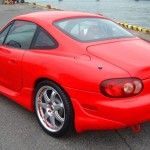 What we’re talking about here is possibly the ultimate formula for a precision handling street car. Features like lightweight, front engine-rear wheel drive, rigid coupe body, short wheelbase and low center of gravity from a compact engine (rotary or boxer) combine to produce the automotive equivalent of a tarmac scalpel or an apex sniper rifle. What makes the BRZ and FR-S better than an actual rotary Miata is that the boxer engine achieves the benefits of the rotary
What we’re talking about here is possibly the ultimate formula for a precision handling street car. Features like lightweight, front engine-rear wheel drive, rigid coupe body, short wheelbase and low center of gravity from a compact engine (rotary or boxer) combine to produce the automotive equivalent of a tarmac scalpel or an apex sniper rifle. What makes the BRZ and FR-S better than an actual rotary Miata is that the boxer engine achieves the benefits of the rotary 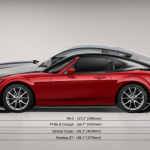 without any of it’s drawbacks. It should be dead reliable with standard maintenance requirements and intervals and my friend is getting over 30 mpg combined in his BRZ. That’s something that no current rotary engine could ever dream of. It also has more storage with the back seat and a roof, though Scion is talking about making a
without any of it’s drawbacks. It should be dead reliable with standard maintenance requirements and intervals and my friend is getting over 30 mpg combined in his BRZ. That’s something that no current rotary engine could ever dream of. It also has more storage with the back seat and a roof, though Scion is talking about making a 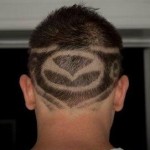 convertible FR-S next year. So if you’re one of those diehard fanatics that wails and gnashes their teeth every time you think of how Mazda is missing out on a huge enthusiast market by not building a rotary MX-5, then you owe it to yourself to at least test drive a Subaru BRZ or Scion FR-S. You can even wear your Mazda hat to the dealership. They probably won’t kick you out for it.
convertible FR-S next year. So if you’re one of those diehard fanatics that wails and gnashes their teeth every time you think of how Mazda is missing out on a huge enthusiast market by not building a rotary MX-5, then you owe it to yourself to at least test drive a Subaru BRZ or Scion FR-S. You can even wear your Mazda hat to the dealership. They probably won’t kick you out for it.
The Power Debate
The Subaru BRZ and the Scion FR-S are Fundamentals Cars. You don’t drive them because they are fast. You drive these cars because they train you to be a faster driver. They allow you to build the skills that will make you faster in any car and situation. No, there 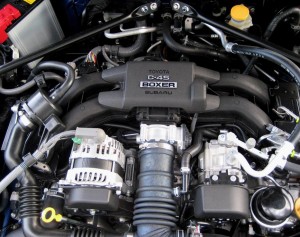 isn’t some mind blowing amount of power, but you have high resolution control over every last bit of the 200 horsepower that’s there. It’s high quality usable power since it’s easy to dial in exactly how much you need or want. With the exception of a slight dip at 3000 rpm (I suspect it’s a lean spot for good gas mileage while doing constant throttle highway cruising), the power delivery increases at a linear and
isn’t some mind blowing amount of power, but you have high resolution control over every last bit of the 200 horsepower that’s there. It’s high quality usable power since it’s easy to dial in exactly how much you need or want. With the exception of a slight dip at 3000 rpm (I suspect it’s a lean spot for good gas mileage while doing constant throttle highway cruising), the power delivery increases at a linear and 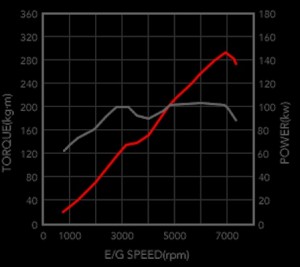 predictable rate with revs and throttle input. Each quarter inch the gas pedal moves gives you the same increase of power as the last. The BRZ and FR-S execute inputs in a transparent manner so you can drive them without having to make up for any strange handling or power delivery quirks. This allows you to build good habits when exploring techniques like tracing the right lines with properly timed turn-in, heel-toe downshifting, trail braking and rolling on the throttle at corner exit without going into a wasteful power slide. When you do it right, the car goes faster. When you do it wrong, you can’t mask your mistake, knowingly or unknowingly, with the car’s power. The car’s speed and attitude provide immediate and accurate feedback for your performance as a driver. Owning and driving the BRZ and FR-S is just like any other form of training. It’s not glamorous and shouldn’t be done to show off (I’m talking to you, guys at the gym who take pictures of weights without lifting them) and it will definitely increase your abilities. In that sense, the BRZ and FR-S are the perfect spiritual successors to the original AE86 Corolla. Many of Japan’s famous professional drivers and drifters cut their teeth behind the wheel of an AE86. It was almost a badge of pride to use a low power car to improve your skills. There was even a Corolla Freshmen Cup racing series for people looking to work their way up to being a pro racer as well as an anime franchise about a young driver who beat high power cars in an AE86 using skills he gained from delivering tofu to the top of a mountain everyday. Having modest power is what makes the AE86 and the FT-86 (Toyota’s chassis code for the BRZ and FR-S) such excellent training tools for the disciplined driving enthusiast who wants to exercise the “built not bought” motto for his or her quick lap times.
predictable rate with revs and throttle input. Each quarter inch the gas pedal moves gives you the same increase of power as the last. The BRZ and FR-S execute inputs in a transparent manner so you can drive them without having to make up for any strange handling or power delivery quirks. This allows you to build good habits when exploring techniques like tracing the right lines with properly timed turn-in, heel-toe downshifting, trail braking and rolling on the throttle at corner exit without going into a wasteful power slide. When you do it right, the car goes faster. When you do it wrong, you can’t mask your mistake, knowingly or unknowingly, with the car’s power. The car’s speed and attitude provide immediate and accurate feedback for your performance as a driver. Owning and driving the BRZ and FR-S is just like any other form of training. It’s not glamorous and shouldn’t be done to show off (I’m talking to you, guys at the gym who take pictures of weights without lifting them) and it will definitely increase your abilities. In that sense, the BRZ and FR-S are the perfect spiritual successors to the original AE86 Corolla. Many of Japan’s famous professional drivers and drifters cut their teeth behind the wheel of an AE86. It was almost a badge of pride to use a low power car to improve your skills. There was even a Corolla Freshmen Cup racing series for people looking to work their way up to being a pro racer as well as an anime franchise about a young driver who beat high power cars in an AE86 using skills he gained from delivering tofu to the top of a mountain everyday. Having modest power is what makes the AE86 and the FT-86 (Toyota’s chassis code for the BRZ and FR-S) such excellent training tools for the disciplined driving enthusiast who wants to exercise the “built not bought” motto for his or her quick lap times.  Besides, this is the car we asked Subaru and Toyota to build. We wanted a hardcore enthusiast car for under $25,000 and that’s what they delivered. The BRZ and FR-S make the same power as the front wheel drive Honda Civic Si and 40 more horsepower than the Mazda MX-5 Miata while having the far and away most competent chassis. There’s also something to be said about a car that can be fun to drive without trespassing into speeding ticket territory. “It’s more fun to drive a slow car fast than it is to drive a fast car slow.” The money you saved on the purchase price and the speeding tickets you didn’t get should buy you some decent bolt-on upgrades when you finally get to the point where your driving skills have outgrown the car’s abilities, which probably won’t be for a good long while. If you do decide to add more power to your BRZ or FR-S, you can rest assured that it has the handling chops to keep the ponies in line. The fact that the FT-86 has a sharp enough chassis to handle way more power than the car comes with is probably the reason you hear so many people say it needs more, not because it actually does.
Besides, this is the car we asked Subaru and Toyota to build. We wanted a hardcore enthusiast car for under $25,000 and that’s what they delivered. The BRZ and FR-S make the same power as the front wheel drive Honda Civic Si and 40 more horsepower than the Mazda MX-5 Miata while having the far and away most competent chassis. There’s also something to be said about a car that can be fun to drive without trespassing into speeding ticket territory. “It’s more fun to drive a slow car fast than it is to drive a fast car slow.” The money you saved on the purchase price and the speeding tickets you didn’t get should buy you some decent bolt-on upgrades when you finally get to the point where your driving skills have outgrown the car’s abilities, which probably won’t be for a good long while. If you do decide to add more power to your BRZ or FR-S, you can rest assured that it has the handling chops to keep the ponies in line. The fact that the FT-86 has a sharp enough chassis to handle way more power than the car comes with is probably the reason you hear so many people say it needs more, not because it actually does.
BRZ or FR-S?
The two cars are nearly identical except for subtle suspension nuances (not full blown differences). Picking between the FR-S and the BRZ will come down to driving style. If you like your car set up loose or are going to do some drifting, pick the Scion FR-S. If  you are more of a grip driver, go with the BRZ. The FR-S costs less, but the BRZ’s premium buys you Bluetooth, navigation, bi-xenon HID headlights and possibly a leather interior and Homelink mirror depending on which trim you get. You can’t go wrong either way. “Hot Lava Orange” is only available on the Scion and “World Rally Blue” is only available on the Subaru. All the other colors overlap. Anything beyond that and you are way overthinking it.
you are more of a grip driver, go with the BRZ. The FR-S costs less, but the BRZ’s premium buys you Bluetooth, navigation, bi-xenon HID headlights and possibly a leather interior and Homelink mirror depending on which trim you get. You can’t go wrong either way. “Hot Lava Orange” is only available on the Scion and “World Rally Blue” is only available on the Subaru. All the other colors overlap. Anything beyond that and you are way overthinking it.
Who Should Buy One of These?
I see the Subaru BRZ and the Scion FR-S as perfect daily drivers for mature car enthusiasts. You get into cars like these after you pass the stage of owning a project car that costs significantly less than the tuning parts you bolt onto it. No more stripping out interiors and ditching air conditioning for “performance gains”, actually getting upset about things said on forums or continuously day dreaming about ludicrously exotic fabrication ideas that will bring you infinite fame and glory. The BRZ and FR-S should appeal to you if you understand the value of a car that can engage your love of driving while at the same time helping you balance your responsibilities as a contributing member of society (i.e. commuting to a career everyday). The beauty of these cars lies in the fact that you get the best of both worlds at an affordable price. That’s what happens when you rely on good physics instead of expensive driver aides and computer control or abusively harsh suspension calibrations. Add to that new car reliability/warranty, comfort and presentability and you are getting a lot for your money.

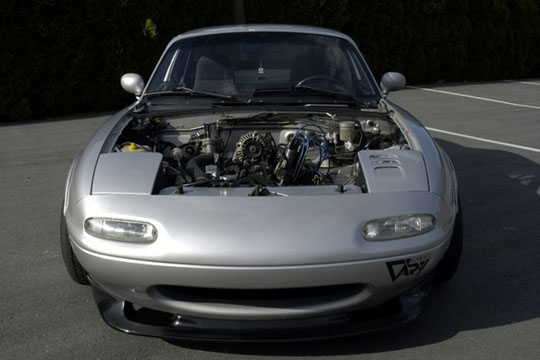
Pingback: Lightweight Sports Car Philosophy – Car and Driver | FluxAuto
Pingback: The Nature of Performance – Chris Harris | FluxAuto
Pingback: Motor Trend’s 2012 Best Driver Car | FluxAuto
Pingback: 86 Day 2012 | FluxAuto